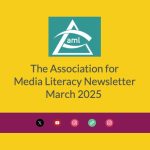Eight Key Concepts of Media Literacy
Media literacy is the knowledge and skills necessary to understand and use the codes and conventions of a wide variety of media forms and genres appropriately, healthily, effectively and ethically. Media literacy educators worldwide use frameworks of varying form and sophistication to scaffold student learning.
Below are eight key concepts of media literacy that can be used to support the understanding and use of media. Each is accompanied by a brief discussion and questions that might help teachers operationalize the statements for student discussion.
Note: These Key Concepts of Media Literacy are neither finite nor immutable. In fact, a current AML initiative is the re-examination and potential revision of these statements to support teachers in evolving media environments.
1. Media construct reality.
Concept #1 focuses on how media represent subsets of real experiences that are made to seem like accurate representations of life. E.g., photographs are realistic, representing objects as seen from a distance, angle and perspective, but are subsets of reality because they are not three-dimensional and do not move.
Questions to support understanding this concept:
- How do the codes and conventions used in this text help to convince its audience that it is representing reality?
- Who is represented in this text; what kinds of people? Who is omitted? How might the omissions be significant?
- What situations or events are represented? What situations or events might be conspicuous by their absence?
- Are the representations accurate or valid? If not, what modifications might make them accurate or valid?
- If you could give the producer of this text some advice about how to improve it, what would it be?
- If you could ask the producer a question about this text, what would it be?
2. Media construct versions of reality.
Concept #2 means that each message is biased in two ways: reflecting the biases of its medium and the biases of its creator. A bias of a medium might be a photograph’s reduction of three to two dimensions and its freezing of one moment in time. A bias of a creator might be a photographer’s decision to omit an element from a photo or to photograph it from a high or low angle. These biases combine to influence the ways an audience makes meaning from the text.
Questions to support understanding this concept:
- What medium/media of communication is/are involved in the construction of this text? (Often more than one are occurring in harmony.)
- Of what other media texts does this text remind me?
- What is the name for this type of media text? or To what category might it belong? (form, genre)
- What are the biases of this medium?
- What are the biases of this media form?
- How might those biases be influencing the meaning(s) people make?
3. Audiences negotiate meaning.
Concept 3. acknowledges the audience’s role in the meaning-making process. Prior knowledge of form and content are critical in the meaning-making process. Activating content prior knowledge is important because it will facilitate new information being synthesized with existing information. Activating form prior knowledge is equally important because it will optimize a consumer’s ability to glean information from the text.
Because each audience member is unique in prior knowledge and life experiences, each member negotiates a unique meaning from a text. No two people see the same movie, read the same message, hear the same podcast, visit the same website. Some scholars suggest that media consumers actually edit their own experiences through selection, attention, time and reflection. This concept is especially important for teachers because they must consider how their and their students’ life experiences, textual competency and intellectual maturity produce different meanings from the same texts. This is why it is so important for teachers to assess—by asking—what meanings students are making and how they are making them. Students’ responses will provide teachers with the information they need to choose and use teaching strategies appropriately.
Questions to support understanding this concept:
- Is this text appealing? To whom?
- To whom might it NOT be appealing? Why?
- Which elements are used to engage/attract the audience (colour, visuals, sound, word choice, celebrities, etc.)?
- What assumptions does this text make about its audience?
- What is my interpretation of the meaning of this text?
- Who might interpret it similarly/differently? Why?
- Does this text “speak” to me? Do I like what it’s saying? Why?
4. Media have economic implications.
It is important to acknowledge that while many media texts are produced by a profit-making industry, more and more are produced just for the pleasure of making and sharing them with a small community. (Andy Warhol is quoted as saying, ‘Everyone will be famous for 15 minutes.’ In the WWW age, the quote has been modified to ‘Everyone is famous to 15 people.’)
The gradual democratization of media production technologies has also had a significant impact on the home and the workplace, and therefore on the education that prepares students for their home and working lives. Where once students might have learned media production in order to enter a media industry, they now must learn media production to succeed in almost any job and to enrich their personal lives. Media production is fast becoming a standard part of many jobs: insurance adjusters must know how to take high-quality photos of damage, then transmit those photos, with their interpretations, to the appropriate agencies; sales people must know how to create effective multi-media presentations to complement their sales meetings and client relations; even funeral directors have to know how to scan old photos, edit them, sequence them, and select and add music to them, produce multi-media presentations that are shown during funeral services, then distributed to family members afterwards. The important idea in these examples is that the term ‘media industry’ is changing and broadening to become a crucial aspect of most jobs and personal lives.
Questions to support understanding this concept:
- Who benefits economically from the production of this text? How?
- Who might be negatively affected economically by this text? How?
- How was the production of this text paid for?/Who funded the production of this text?
- How do the funders make a profit from this text?
- If the funders DON’T make a profit, what DO they get from the audience’s consumption of this text?
- What do consumers pay to consume this text??If consumers DON’T pay any money to consume this text, what might they sacrifice (time)?
- If this text contains NO commercial implications, why was it created? (pleasure)
5. Media communicate values messages.
Concepts #5 and #6 are becoming increasingly important as the rate of change accelerates. Concept #5 helps students consider that media messages inevitably communicate values messages that extend into the lives of their audiences. Audiences need to be able to recognize and assess these values messages. This statement connects with the notion of creator bias described in concept #2.
Dominant and subordinate social groups have become aware of the values that texts communicate. This is evidenced by the creation of and loyalty to creators that serve subordinate social groups. Immigrant, Native, female and Trans-gendered, Gay, Lesbian and Bi-sexual communities have all sought opportunities for self-expression and assertion of their values through media texts and media communities.
Questions to support understanding this concept:
- Whose values are represented?
- Whose values are NOT represented?
- Does the text misrepresent any values?
- Are my values/beliefs represented?
- Are my friends’ values represented?
6. Media communicate political and social messages.
Concept #6 helps students understand that because media messages are shared, discussed and sometimes emulated, they need to be explored within a sociopolitical context to assess how they are influencing—or are influenced by—consumers. Political parties are utilizing social networking and other web resources extensively. Marketers are pursuing potential customers ever more persistently. People are often making buying and life decisions within virtual social contexts rather than through face-to-face contacts. It is possible to shop online for books, movies, appliances, airline tickets etc. and to not only see the ratings provided by commercial ratings services, but also ratings provided by other consumers. This means that consumers can make purchasing, and possibly voting, decisions in a social environment comprised of people they have never met, nor will ever meet, yet with whom they are (temporarily) working towards common goals.
Cyber-bullying is an ongoing preoccupation in many quarters. Each of these issues can be informed using this key concept.
Questions to support understanding this concept:
- What assumptions does the producer make about the audience? (gender, race, class, interests)
- Who benefits from the production of this text? How?
- Who might be negatively affected by this text? How?
- What is this text’s political point of view?
- How might this text influence its audience’s political point of view?
7. Form and content are closely related in each medium.
Concept #7 is particularly important in the production of media texts because it refers to the fact that the unique codes and conventions of each medium influence—and are influenced by—the content of the messages. It is also an important concept because it acknowledges the unique language of each medium.
Questions to support understanding this concept:
- What media form is this?
- What media genre is this?
- How do the form and genre shape the content of the text?
- How does the content influence the characteristics of the form?
8. Each medium has a unique aesthetic form.
Concept #8 acknowledges the pleasures that media texts provide, either through their entertainment value or their effectiveness. This concept acknowledges that each medium not only has a unique set of codes and conventions (as stated by key concept #2), but that there is an aesthetic involved in their appropriate and pleasurable uses. It may be easier to consider aesthetics in media forms or texts that are purposefully artistic or entertaining: music, movies, TV shows. It is important, however, to help students understand and appreciate the aesthetics that might occur in news reports, advertisements, blogs and podcasts. There can even be aesthetic qualities in their own assignments.
It is unfortunate that this is the last concept, because it is not the least important, though readers might infer so from its position. Being last, it also is vulnerable to neglect or omission when time constraints occur. Teachers might choose to begin with this key concept, as it invites students to discover and share their own pleasures—a good place to start for affective reasons—and aesthetics can implicate all the other key concepts.
Questions to support understanding this concept:
- What set of codes and conventions combine to communicate the aethestics of this text?
- What makes this a pleasurable text?


